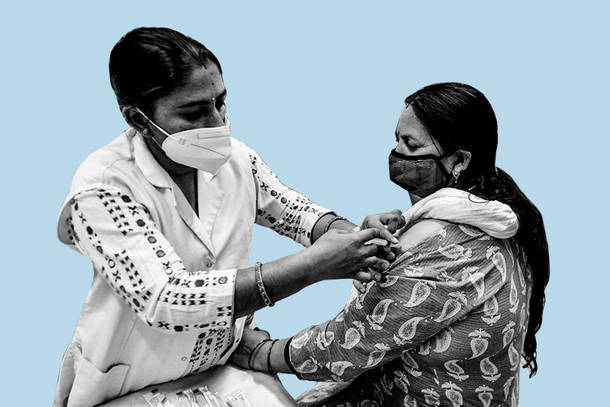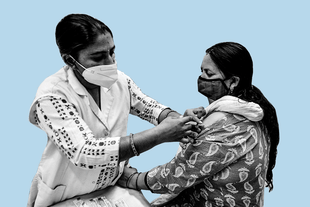Politics
How To Mess Up A Flawed Vaccine Drive With One New Bloomer Daily: Lessons From Experience
R Jagannathan
May 12, 2021, 11:18 AM | Updated 11:17 AM IST
Save & read from anywhere!
Bookmark stories for easy access on any device or the Swarajya app.


India’s politicians have made a complete mess of our Covid vaccine programme. We already knew last month, when vaccinations were thrown open to the 18-44 age group, that there was simply not enough to go around.
But the states, after having made political demands to extend the drive to all adults, made a big show of vaccinating the newly eligible groups right from the first week of May, at a time when supplies were dwindling and there was little chance of any improvement in available dosages till at least July-August.
Now, faced with the reality that a large majority of the above-45 age groups will be stuck without a second dose, the Centre has reportedly threatened to cut vaccine supplies to states that do not achieve at least 70 per cent delivery of the second dose for those eligible.
Speaking from my own experience with the relative non-availability of the second dose in Thane, Maharashtra, I know that we are in deep trouble.
Unless the Centre and states stop blaming each other for the problems, things are going to get worse, not better. Vaccine strategy cannot be invented or reinvented on the go where we force the entire population to rush to vaccine centres daily by creating a shortage psychosis.
I will briefly state my experience with the vaccination drive in Thane to point out obvious flaws in the way it is being arbitrarily implemented even though everyone knows that there is a huge shortfall.
I got my first dose of Covaxin in the last week of March, and the second dose was due by the second week of May in order to stay within the 42-day limit set under the central protocol.
But Covaxin, where the shortage is even worse than in Covishield, was not only administered to the newly added 18-44 age groups, but all second doses were effectively shifted to walk-ins. This meant that those who wanted to get their second doses had to wait in long lines every day. And still not get it. This problem will compound as the 18-44-year-olds given Covaxin and Covishield add to the second dose demand some time between June and July, when supplies will still remain crunched.
Senior citizens and people with co-morbidities have had to queue up outside vaccine centres with daily dosage availability in the range of 50-100 doses. More often than not they have to go away without getting their jabs as the available slots are quickly filled within minutes by people. The average dosage available in 26 centres delivering Covaxin jabs today (12 May) is 95.
These jabs apparently cannot be scheduled through the Co-Win app; every slot I tried at many centres said all slots booked. But the Thane Municipal Corporation has indicated that the slots will be through walk-ins.
Now, walk-ins are the worst possible idea in a situation of shortage, for it means people will queue up for hours just in order to beat the dosage availability limit for the day.
When I went to the vaccine centre closest to my place, I found over 100-120 people already in the queue for the 110 jabs available, and this was at 8.15 am for a vaccine schedule that begins at 12 noon. So, you have nearly four hours of wait and then another 1-3 hours after you get in to get the actual jab.
How many senior citizens, do you think, can handle this, and what is the point in making the vaccine drive itself a super-spreader event since queues in India cannot be maintained with do gaz ki doori?
The best you can achieve is one foot between one person in the queue and another. Sometimes even this is not possible if the line is longer, and people at the fag end start getting impatient and start pushing. Consider what kind of ordeal we are putting the poor of the country through every day in queues of various kinds.
Walk-ins are a bad, bad idea in an era of shortage. Walk-ins make sense only in situations of plenty, when one can literally walk in with minimum effort to get what one wants.
In contrast, most people I know had a good experience with their first jabs, since the vaccinations were scheduled through the Co-Win app. I landed up at the Global Impact Hub 2 at 8.45 am on 27 March, was let in by 9am, and I waited till 10.15 am to be let into the actual vaccination hall.
As I was among the first to arrive, I got my work done by around 10.45-11 am – two hours in all. Those who arrived later would have had to spend three or four hours, but would still not have minded it for there was certainty about getting the jab and a decent place to sit and wait for your turn.
This can’t be said about the second jab, which, we were told, needed no appointment. I didn’t think much about it at the time of the first jab, but now I realise it is the wrong thing to do. The second jab should also be scheduled through the app. I know, for I have spent every alternate day over the last 10 days going to some vaccination centre or the other to find slots for my spouse and me, but never found one without very long queues, where the risks of contracting Covid are large.
The simple lessons to learn are the following.
One, all second doses should also be by appointment in a situation of shortage. The app should allow for automatic rollovers to new dates in case some slots are too full and dosages fall short for some reason. This way, there may be delays in receiving the shots, but no crush and super-spreader events during the vaccine drives.
Two, we need a complete and honest statement from both Centre and states on what kind of numbers can actually be vaccinated this month, the next month, and in July, assuming all avenues (including likely imports and production expansion) are taken on board.
Additional slots should not be booked till the backlog of those already registered on the Co-Win app is cleared, and second doses scheduled. Vaccine jabs for the poor should not be walk-ins, but delivered closer to where they live. Mobile vans should be used to reach out to the poor anywhere when doses are available.
Three, if the scientific opinion is that maximising first doses for as many people as possible would be better than trying to give every first dose recipient the second dose when due, then this should be stated openly, and the drive widened to speed up first doses. Second doses can be given as and when possible, through appointments made on the app – by earmarking, say, 10 per cent of the total available on any day.
Four, the 18-44 age group should be entirely put on the new vaccines that become available from now on (Sputnik-V, Pfizer, etc), based on expected imports and domestic production schedules.
Five, vaccines should be free (and prices fully negotiated by the Centre with manufacturers). States should, however, be free to import them from any manufacturer abroad (assuming local supplies fall short till the end of the year) at their own cost.
One can see Delhi, a rich state, being able to do this. Other rich states, Maharashtra, Tamil Nadu and Karnataka, for example, can also go in for high priced imports. They can rope in rich corporates (Reliance, TCS, Infosys, etc) to buy these vaccines not only for their staff, but for the wider public too.
States can provide the spaces and medical resources for the same. A vaccine imported at Rs 1,000/- per jab will cost a corporate Rs 100 crore per million – not something unaffordable for the richest companies and philanthropists of India.
A city like, say, Bangalore, can surely get its rich IT companies and millionaires to cough up Rs 100 crore each to vaccinate upto 5-10 million residents in the next three months. Hospitals should also be allowed to import or buy domestic supplies (when they become surplus) to deliver the jab for those who can afford it at commercial rates.
A vaccine policy that is incrementally created through political pressure is not only sub-optimal, but also counter-productive. Centre and states must act together, and not indulge in more finger-pointing.
As the cliche goes, for every finger pointed at someone else, three point towards you. Politics has already made our vaccine programme the worst thought out one so far. Do we want this to continue?
Jagannathan is former Editorial Director, Swarajya. He tweets at @TheJaggi.





